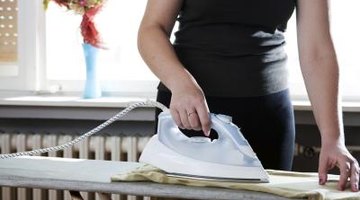Ceramic Irons Vs. Stainless Steel Soleplates
Table of Contents
Irons are everyday household appliances we sometimes take for granted. No one really likes to iron clothing, even with today's technologically advanced steam tools. Irons have come a long way from the heavy pressing devices that once burned many women's hands because they were heated directly in fire.

Stainless Steel

Most irons have a stainless steel soleplate. Also known as inox, this alloy steel contains 10 to 30 percent chromium which makes it non-corrosive and heat-resistant.
Ceramic

Some irons have a coat of ceramic over the aluminum metal or plastic soleplate. Ceramic is an inorganic material, usually made of clay, that becomes hard and brittle when fired. A layer of ceramic is bonded or baked onto the plate.
Benefits of Ceramic

Ceramic is a good conductor of heat and helps to distribute it evenly across the surface it covers. It's durable, eliminates static and prevents clothes from sticking to it at high heat.
Stainless Steel Benefits

Stainless steel is a durable and hygienic metal because it can be easily cleaned. It allows for even heat distribution.
Limitations

Lower quality ceramic soleplates may wear or peel over time. Stainless steel irons may stick to decals or glues on clothing at higher heats. Both types are likely to snag or melt fine, lightweight materials such as silk at high temperatures.
The Drip Cap
- Irons are everyday household appliances we sometimes take for granted.
- Irons have come a long way from the heavy pressing devices that once burned many women's hands because they were heated directly in fire.
- Some irons have a coat of ceramic over the aluminum metal or plastic soleplate.
- It's durable, eliminates static and prevents clothes from sticking to it at high heat.
References
Resources
Writer Bio
K.C. Hernandez has covered real estate topics since 2009. She is a licensed real estate salesperson in San Diego since 2004. Her articles have appeared in community newspapers but her work is mostly online. Hernandez has a Bachelor of Arts in English from UCLA and works as the real estate expert for Demand Media Studios.
Photo Credits
- George Doyle/Stockbyte/Getty Images
- George Doyle/Stockbyte/Getty Images
- yalcinsonat1/iStock/Getty Images
- Top Photo Corporation/Top Photo Group/Getty Images
- Les Cunliffe/iStock/Getty Images
- Marjan Veljanoski/iStock/Getty Images
- Vladimir Semenov/iStock/Getty Images
More Articles



